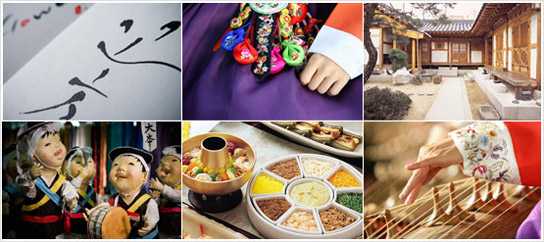| Han Style |
 Asian countries have been doing exchanges through culture and trade throughout history. Trends spread throughout the region at an incredibly fast rate. The 80's were a time for “Hong Kong Noir” while the 90's were more an age of Japanese animation. The 2000s have seen a sharp rise in the popularity of Korean culture, with music and dramas hitting all the right notes. Interest in Korea, triggered by the success of leading Korean dramas and popular music, continues to escalated to include a host of other aspects of Korean culture, such as hangeul (Korean alphabet), hansik (Korean food), hanbok (traditional Korean clothing), hanok (traditional Korean houses), hanji (traditional Korean paper), as well as Korean music. In Korea, the aforementioned six cultural symbols are collectively referred to as “Han Style”. Asian countries have been doing exchanges through culture and trade throughout history. Trends spread throughout the region at an incredibly fast rate. The 80's were a time for “Hong Kong Noir” while the 90's were more an age of Japanese animation. The 2000s have seen a sharp rise in the popularity of Korean culture, with music and dramas hitting all the right notes. Interest in Korea, triggered by the success of leading Korean dramas and popular music, continues to escalated to include a host of other aspects of Korean culture, such as hangeul (Korean alphabet), hansik (Korean food), hanbok (traditional Korean clothing), hanok (traditional Korean houses), hanji (traditional Korean paper), as well as Korean music. In Korea, the aforementioned six cultural symbols are collectively referred to as “Han Style”.  The Korean Wave that swept its way through Asia starting with dramas and popular music is now achieving even far greater appeal in the international market. As it continues to evolve it enriches the image of Han Style. Hangeul: The Korean alphabet, a very scientific writing system that has been designated by UNESCO as an important part of the Memory of the World Heritage. As a result of the Korean Wave and Korea 's economic prosperity, the desire to learn hangeul and the Korean language is exploding. Hansik: Korean food continues to gain popularity throughout the world for its incredible health benefits. Hanbok: The focus of attention when Daejanggeum (Jewel in the Palace), a TV drama on royal court cuisine, became popular in Asia. Modifications of the exquisite colors and designs of the hanbok are also used as motifs in all Korean-style designs. Hanok: Many international visitors are showing interest in the traditional Korean home, hanok as they want to experience ondol, the Korean floor heating system very effective in the cold winter. Ondol is an important aspect of Korea' s unique architectural style, and brought floor heating into vogue globally. Hanji: A traditional form of paper that can last for over one thousand years and is known for its outstanding quality and elegant designs. The paper is drawing attention not only for record-keeping purposes but also for interior decoration and for it’s uses in paper wrapping. Hanguk Eumak: Traditional Korean music that has slow-rhythm and sentimental lyrics that epitomize the sad history of Korea. Such unique Korean sentiments had significant influence on Korean popular music and drama and are an important driver of the Korean Wave. Experience Hanstyle at TIC |
Located in the southeast region of the Korean peninsula, Busan is the country's largest port city and boasts an abundance of coastal tourist attractions, historical and cultural sites, and trendy shopping areas. The city has a well-developed public transportation system, but for a more convenient and all-inclusive tour, hop aboard the Busan City Tour. The Busan City Tour is comprised of a variety of one-day courses that cover some of the area's major attractions (Haeundae Beach, Taejongdae Resort Park, BEXCO, Jagalchi Market, Dalmaji-gil Road, etc.). The Circulatory Tour covers Taejonogdae Resort Park and Haeundae Beac; the History and Culture Exploration Tour includes major historic sites; the Natural Ecology Tour introduces the rich ecosystem of Busan; the Night View Tour shows some of the city's most fascinating nighttime attractions. Each seat on the bus is equipped with an individual TV screen, providing visitors with information about the stops along the way in a p...
Comments
Post a Comment